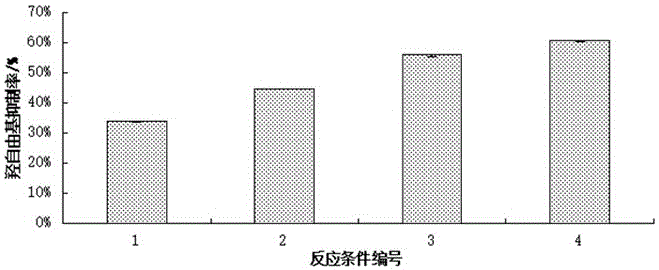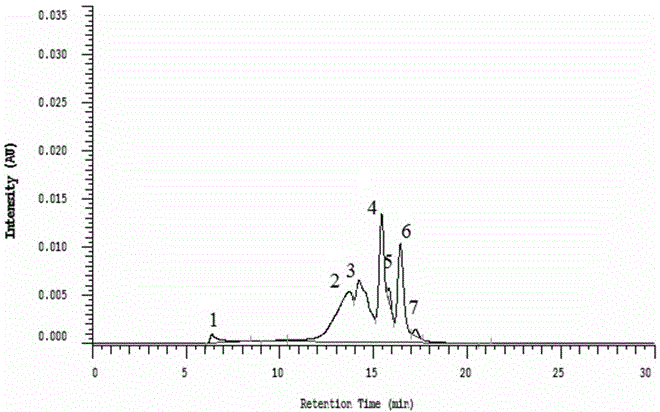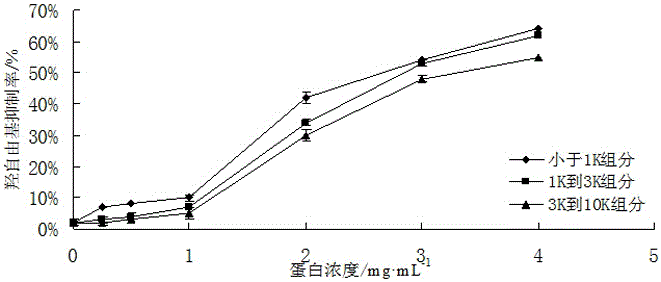Method for preparing bioactive peptide from canned fish production waste liquid
A technology of biologically active peptides and waste liquids, applied in the preparation methods of peptides, chemical instruments and methods, and medical preparations containing active ingredients, etc. Reduced production cost, high economy, good effect of ACE inhibitory activity
- Summary
- Abstract
- Description
- Claims
- Application Information
AI Technical Summary
Problems solved by technology
Method used
Image
Examples
Embodiment 1
[0024] Embodiment 1 Determination of compound enzyme reaction system
[0025] The four reaction systems compounded by alkaline protease and trypsin are shown in Table 1. The enzymatic hydrolysis effects of different reaction systems were investigated with the hydroxyl radical scavenging rate as an index. The results are shown in figure 1 .
[0026] Table 1 Different complex enzyme reaction systems
[0027]
[0028] Such as figure 1 As shown, the effect of system 4 is the best, that is, trypsin is firstly added for reaction, the reaction temperature is 55 ℃, and the time is 4 h; then alkaline protease is added for reaction, the reaction temperature is 60 ℃, the time is 3 h, the corresponding The hydroxyl free radical inhibition rate is as high as 61%, which is 21.47% higher than the result of alkaline protease single-enzyme hydrolysis (39.53%), 40.17% higher than the result of trypsin single-enzyme hydrolysis (19.83%), and higher than alkaline protease and The sum of the ...
Embodiment 2
[0029] Embodiment 2 Composite enzyme hydrolyzate molecular weight distribution
[0030] Add trypsin in the amount of 7450 U / g to the waste liquid of canned fish production, react at 55°C and pH 8 for 4 h; Continue to react for 3 hours, use TSK-gelG3000sw chromatographic column to analyze the molecular weight of the enzymatic hydrolysis product, the results are as follows figure 2 , Table 2.
[0031] Table 2 HPLC analysis results of compound enzyme hydrolysis products
[0032]
[0033] It can be seen from Table 2 that after hydrolysis with alkaline protease and trypsin, the components with a molecular weight of less than 1 KDa accounted for 50% of the product, which was higher than that of alkaline protease (30%) and trypsin (28%) The effect of enzymatic hydrolysis shows that the use of segmented compound enzymatic hydrolysis can greatly increase the yield of small molecule peptides.
Embodiment 3
[0034] Example 3 Study on the Activity of Compound Enzyme Hydrolyzate
[0035] Using ultrafiltration membranes with different cut-offs (10 KDa, 3 KDa, 1 KDa) to separate the complex enzyme hydrolysis products, the molecular weight is <1 KDa (P1), 1 KDa-3 KDa (P2), 3 KDa-10 KDa (P3) of the three components.
[0036] 1. Antioxidant activity research
[0037] 1.1 Hydroxyl free radical inhibition experiment
[0038] The curve of the inhibitory effect of the three components in the compound enzyme hydrolyzate on hydroxyl radicals as a function of concentration is shown in image 3 .
[0039] Depend on image 3 It can be seen that all three components have inhibitory effects on hydroxyl radicals, and the increase of the inhibitory rate is positively correlated with the dose of the components; among them, the inhibitory effect of P1 component on hydroxyl free radicals is relatively good.
[0040] 1.2 DPPH free radical inhibition experiment
[0041] The curve of the inhibitory e...
PUM
 Login to view more
Login to view more Abstract
Description
Claims
Application Information
 Login to view more
Login to view more - R&D Engineer
- R&D Manager
- IP Professional
- Industry Leading Data Capabilities
- Powerful AI technology
- Patent DNA Extraction
Browse by: Latest US Patents, China's latest patents, Technical Efficacy Thesaurus, Application Domain, Technology Topic.
© 2024 PatSnap. All rights reserved.Legal|Privacy policy|Modern Slavery Act Transparency Statement|Sitemap



